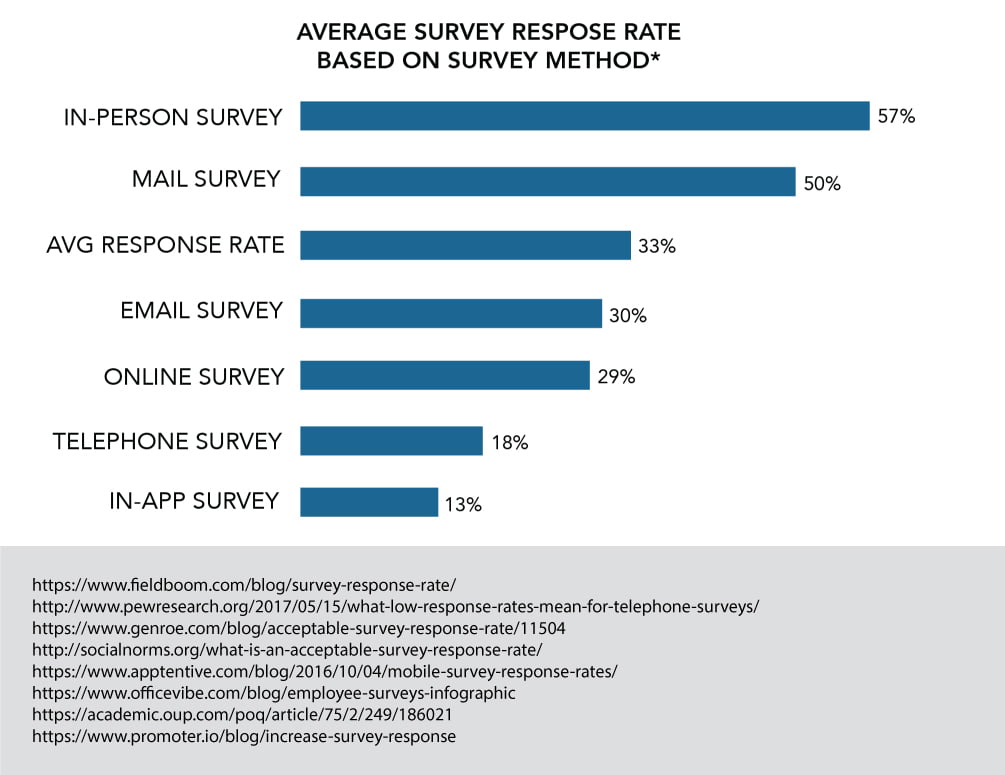3 Survey Incentives to Explode Your Response Rate
So, your compelling survey is ready. Your questions are set, the forms are designed, and your mailing list is finalized. Then suddenly, it hits you. What if you don’t get enough responses?
Enter “Survey Incentives.”
While mail surveys are proven to deliver the highest response rates in the industry[1]* (save for in-person surveys), the use of incentives has been shown to significantly increase response rates across the board – including those by mail, email, online, telephone, in-app, in-person and multi-modal. In fact, the vast majority of surveys today use them. But which ones work best?
You should consider several factors when choosing your incentive offer, including budget, target audience, and timeliness, as well as ease of fulfillment. That said, survey incentives can be grouped into categories that perform similarly.
Following are the 3 survey incentive types you can use with confidence because they are proven to work, helping mail surveyors reach target response rates of up to 40% or more+:
1: Money for Survey Incentives
This should come as little surprise. Who doesn’t like money? Monetary incentives include cash, checks, PayPal credits, money orders, gift cards, coupons, and more. The question is… how much do you offer? Well, there are 2 ways to go about this.
- a) Pre-incentive – Also known as a token incentive, these are sent inside the survey whether the respondent completes it or not. Offering cash up front is an effective strategy for many. As little as a $1 bill inside the survey packet has been shown to significantly increase response, as many respondents feel compelled to give back once they have pocketed the money. According to Don Dillman, Regents Professor in the Department of Sociology at Washington State University and Deputy Director for Research and Development in the Social and Economic Sciences Research Center (SESRC), “Previous studies have consistently shown that token incentives of a few dollars included with the request for survey participation increases the likelihood that subjects will respond.”[2]And this does not vary statistically by payment method (i.e. cash vs. check). The important consideration here is how each will impact your budget? While it may cost more to print & issue the checks, studies have shown that close to half of the respondents will never cash them! If budget is a concern, the size of your incentive may validate going this route to try and bring the cost down.
- b) Promised offer – This is an offer a respondent will receive after completing the survey. This method is also effective, but naturally, the monetary incentive must be higher since they will have to wait for it. According to Dillman, token incentives have historically yielded higher response rates than promised offers, but research is ongoing. Rewards Cards, in particular, have been shown to increase response rates dramatically, and have become the new standard in promised offers. They do, however, present unique concerns, such as cards expiring and determining who keeps the money from unused balances. DataForce research has shown that promised incentives valued at approximately $10-50 per respondent are most effective, with $20 and $25 denominations most common. Important considerations when choosing a monetary value for promised offers include the length of the survey, the target audience demographics, and your relationship with the participant. No relationship will require a larger incentive than people who know you or your brand. Another strategy with promised offers, if your budget can afford it, would be to combine this approach with the token incentive approach, to encourage even more responses!
To learn more about Reward Cards, read our post on The Truth Behind Gift Card Incentive Offers.
2: Promotional Item for Survey Incentives
Product and service samples are also a big hit with respondents. In order for them to work, however, you must know your audience. Offer something that speaks to them that you know they will enjoy. A sample directly related to the survey is ideal, but anything of value to your audience can be effective. For example, If your selected respondents by and large support environmental causes, you might offer them a sample of a new eco-friendly product or service. Your goal is to find the sample product or service that best speaks to your target and stays within budget.
3: Charitable Donations for Survey Incentives
Charitable donations appeal to all socioeconomic groups, as we all have local and global causes we care about. However, this category in particular, requires that you know your audience. The stronger the emotional connection to the cause, the better your response rate will be and the more likely respondents will see you in a favorable light. Charitable donations also qualify for tax deductions, so you may choose to offer a higher value incentive.
Perhaps just as important are the incentive types we left off this list, particularly drawings.
About Drawings
A drawing (or raffle/sweepstakes) incentive gives your respondents a random chance to win a valuable prize, as opposed to a contest based on merit. They simply complete the survey and are automatically entered to win something. Since you won’t be giving away the big prize(s) to everyone, you are able to offer the bigger-ticket item(s) that could really appeal to them. However, there is one major drawback that keeps it off our recommended list – strict legal requirements.
If you want to do a drawing, make sure that you review with your legal counsel in order to determine whether it adheres to federal and state guidelines. The two most essential requirements are:
- Providing a means for anyone who is contacted to participate in the drawing even if they decide not to complete the survey. This cannot be done online because that would discriminate against people without internet.
- Provide a written copy of the rules, including terms and conditions, eligibility, start and end dates, and other details specific to state laws in every state where respondents live (and in every country if any live abroad).
Other incentives worth considering are industry white papers, branded giveaways, and a promise to share the survey results with them, depending on your target audience. These can also generate a significant bump in response rates, but not as dependable as our top 3.
While some have raised concern over potential demographic bias when using incentives, research has proven otherwise. Countless studies have determined that incentive offers have no adverse effect on the sampling of results. Rather, they have been shown to increase response rates evenly across respondent subgroups and improve data quality. The question is not whether to use them, but rather which ones will resonate most with your audience.
If you’d like more information on incentives, survey research, incentive fulfillment services or survey mailing services in general, contact us today!






